In private houses there are always autonomous heating systems. And if their functioning occurs with the use of water, then it becomes necessary to install an expansion tank. Its main function is to prevent overpressure in the heating system. Therefore, its installation is very important. Going to buy an expansion tank, many do not know which one to choose. After all, the range of such products is more than diverse. Therefore, without practical recommendations here can not do. They are presented below.
It is very important to know how to choose expansion tank for the heating system, so that there are no emergencies.
Decide on the type of expansion tank
Manufacturers of tanks for the heating system offer them in a variety of designs. However, all of them are divided into two types: open and closed. The first is large structures that are inefficient. For this reason, they are very rarely used. So, the choice must be made in favor of the second type - closed tanks. They are containers of spherical or flat shapes. They have high tightness and compact dimensions. Inside such tanks are separated by heat-resistant membranes. As a result, the container consists of two parts. I must say that such expansion tanks are often called membrane. Their principle of operation is based on the fact that under the influence of temperature, the expanding coolant enters the container, during which the heat-resistant material is stretched, the volume of air in the tank decreases, as a result of which the pressure in the heating system returns to normal.
![]()
But these are not the only advantages that membrane tanks have. Another advantage is that the air in them does not come into contact with water, which allows you to increase the life of the entire heating system. You can install such tanks anywhere in the house, even in the attic. In this case, you do not need to worry about frostbite, as is the case with open-type structures. Again, due to the presence of a membrane that separates air from water, oxygen “bubbles” do not appear in closed tanks, as in the entire heating system.
Determine the volume of the expansion tank
If you choose a tank for the heating system that does not fit in volume, then it will not function effectively. That is why it is so important to pay attention to this parameter and decide on it.
It should be borne in mind that the greater the length of the heating system and the higher the temperature of the coolant in it, the larger the volume of the tank should be. Along with this, the following rule must be taken into account: the higher the pressure in the heating system, the smaller the volume of the expansion tank should be. It may seem that the method by which you can determine the optimal volume of the tank is very complicated, because here you need to provide for many parameters. But this is only at first glance, since there is a special formula that simplifies the whole process. It is important to study it in detail in order to avoid a mistake when choosing the volume of the expansion tank that is needed.
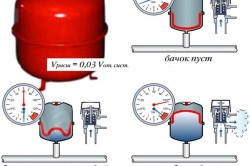
So, the main value, on which the result largely depends, is the total volume of the coolant in the existing heating system. It is necessarily calculated taking into account the power that the boiler has and the number of heaters. Their figures look something like this: convector - 6.9 l / kW, underfloor heating - 16.9 l / kW, batteries - 10.5 l / kW. The formula itself looks like this:
Vtank= (Vsys*k)/D
Now let's decrypt it:
- Vsyst is the total volume of water present in autonomous system home heating;
- k is the coefficient inherent in the expansion of the coolant (for example, if the water is heated to 95 ° C, then it will be equal to 4%);
- D - tank efficiency.
Many may have a question as to how the efficiency level of an expansion tank can be determined. There is another formula here that will help you make accurate calculations. It looks like this:

Table of the expansion tank coefficient (volume increase) of water and water-glycol mixture depending on the heating temperature.
D = (Pmax-Pstart)/ (Pmax+1)
It is decoded like this:
- Pmax is the maximum pressure in the system to which the safety valve is adjusted;
- Pstart is the initial pressure level present in the air chamber.
It follows from this that the selection of the volume of the expansion tank takes into account many parameters. They all need to be taken into account in order to make the right calculations. In this case, the resulting figure should be equal to the volume of the tank or be slightly larger than it.
Choosing the best pump
To make heating more efficient and ensure the high-quality functioning of the expansion tank, it is imperative to purchase a pump for it. Here, making the right choice can also be quite difficult. In order to avoid mistakes, you should be aware that pumps with a power of up to 1.2 kW are suitable for a tank with a volume of 20 to 25 liters. If the capacity is larger and holds more than 50 liters, then you need to purchase more powerful devices. Pumps designed for 10.5 - 20 kW are suitable here.
We pay attention to quality

The service life of the expansion tank largely depends on how high quality it is. It is absolutely clear that a cheap container made of unreliable materials will last only a few years, after which it will leak. Therefore, it is so important not to choose tanks, the cost of which is at a minimum level. However, when buying fairly expensive products, you need to pay attention to their quality, because a high price is not a guarantee of a long service life. So be sure to inspect the tank. Pay attention to his seams. They must be accurate and complete. Otherwise, there will be a big problem with the tightness of the container.
In addition, you need to inspect the tank for defects, because choosing a product with such will be a fatal mistake. Here you need to find literally the perfect product, because this is the only way to be sure that the technology was not violated during the manufacture, and the transportation was carried out in accordance with the basic rules and regulations. Tanks without any defects used in heating systems serve for a long time and please with uninterrupted operation. At the same time, their high quality and impeccability must be confirmed by appropriate European or international certificates. In addition, they must comply with hygienic standards and be resistant to diffusion.
Choice of cistern design
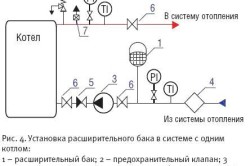
As mentioned above, expansion tanks are offered in specialized stores in a variety of designs. They differ not only in style, but also in form. You need to choose the design of such a container based on your needs, as well as the availability of free space. After all, it happens that in a room it is possible to install a tank only of a rounded shape or a rectangular one. Therefore, before buying, it is important to decide on the place where you plan to install it in the future and accurately identify the dimensions of the available free space, so that later you do not have to change the product or look for another room for its installation.
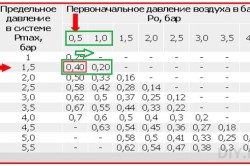
As for which color is better to choose for the expansion tank, then you need to focus on the design of the room. So, if you decide to install it in the bathroom or toilet, then make sure that its coloring is ideal for the interior. And if you place it in the attic, where you look only occasionally and at the same time it is not equipped with you, then choose a tank of any color, because here this parameter no longer plays an important role.
Summing up
From the information provided, it is clear that choosing an expansion tank for your heating system is a responsible matter and has a lot of nuances. However, if you follow the above tips, you will be able to choose the best product that perfectly suits your requirements and needs.
Therefore, do not neglect them, because only in this way you will be able to make the right choice and make a really good purchase. The installed expansion tank will fully cope with the assigned tasks, which will ensure the high-quality operation of the heating system.
In the structure of the heating system, it is necessary to provide for the presence of all structural elements. To exclude even one of them would be unjustified for two reasons. Firstly, it can negatively affect the functionality and efficiency of the entire system. And secondly, such imperfect projects can be dangerous in relation to possible fires or breaks in pipeline communication.
One of such important structural elements of heating systems is an expansion tank for heating. During the heating of the coolant in the line, there is an increase in pressure and an increase in the volume of the coolant itself, which is due to the clear action of physical forces. At this time, critical parameters are created in the supply line of the pipeline, which, in the absence of an expansion tank, can provoke the exit of the coolant from the pipe. Typically, such incidents are accompanied by a pipeline rupture at the weakest point of the junction of individual elements.
To exclude the likelihood of such a development of events, the installation of an expansion tank for heating is provided for in the structure of the heating system. In the absence of an expansion tank, excess water will have to be drained each time the system is heated. In this case, air pockets may occur, which are formed when the coolant cools in the pipeline.
Which expansion tank for heating to choose?
The classification of these structural elements of the heating circuit provides for two categories of devices:
- Tanks of open type;
- Tanks of the closed type.
To the first category include outdated models for use in systems with natural circulation of the coolant in the system. These are containers with an open top and a nozzle for detecting and removing excess water in the system.
The second category includes the use of fully sealed containers equipped with an outlet valve to remove air and excess coolant. Exhaust valves in such expansion tanks for heating can be mechanical with manual removal and automatic - equipped with pressure gauges and appropriate automation. This category of expansion tanks is used when installing a heating system with natural or forced circulation coolant.
Option three - membrane tank for heating. This model is more perfect, has more practicality and aesthetic appearance. Its device assumes the presence of two compartments in the design of the tank. One of them contains air under pressure, and the other is supplied with a coolant that has expanded as a result of heating.
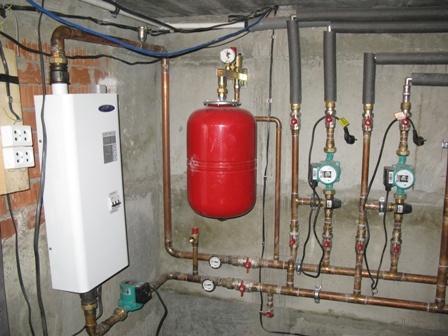
Both compartments are separated by a strong and plastic membrane. When the coolant fills the capacity of its compartment, it creates increased pressure in another compartment. When the water cools, the excess pressure in the other compartment forces it back into the heating system pipeline. Thus, a constant volume of coolant and pressure in the system are maintained.
How to choose the volume of the expansion tank?
When the type and location of the tank has been determined, now it is necessary to select the calculation of the volume of the vessel. You can calculate the volume of the expansion tank for heating in different ways.

Professional calculation - are made by design engineers who use special equipment. Specialists and engineers take into account all the factors that can somehow affect the stability of the heating system. Many people use only this method, as it is the most reliable, accurate, but also expensive.
Special calculator for calculation - various Internet sites make it possible to calculate the volume of expansion tanks. The calculator makes it possible to obtain information on the minimum required capacity of the containers in question. This method can only be applied to individual heating systems.
Calculation by formulas - usually done on its own. A person must be very careful not to make a number of mistakes. On various portals you can find the necessary formulas that will help you decide the volume of the expansion tank.

Choosing an expansion tank for heating systems - video
The choice of an expansion tank is a situation in which knowledge of the most popular and reliable manufacturers is not enough. In this case, you will have to remember elementary physics, which some did not learn at school, while others tried hard to forget. The fact is that the molecules of a liquid, when heated, change their volume in the direction of increase, and when cooled, they return to their previous volume. Expanzomat (the professional name for an expansion tank) in the heating system plays the role of a kind of compensator, a reservoir for expanding and cooling liquid. If the water in the circuit is hot, the tank holds the excess, and when the water cools down, it returns the water to the system.
In a professional locksmith environment where heating equipment, you can find these types of heating systems - open and closed. The same classification for tanks. In the first type of systems, the fluid moves according to natural laws. The main task is to place the tank above any element in the heating circuit. It can be both an attic and a place under the ceiling. In this case, ready-made containers become the expansion tank, which are modified and finalized, or steel sheet structures are welded. There are few requirements for such a tank, even the capacity is not so significant - at least 5 liters. Despite its simplicity, it has many disadvantages:- constant contact of liquid with water accelerates the process of oxidation of heating radiators and connecting steel pipes;
- the liquid evaporates under the influence of temperature - it is necessary to constantly monitor its level;
- the size of open tanks not only spoil the interior, but also cause inconvenience;
- open tanks that are mounted outside the premises must be insulated.
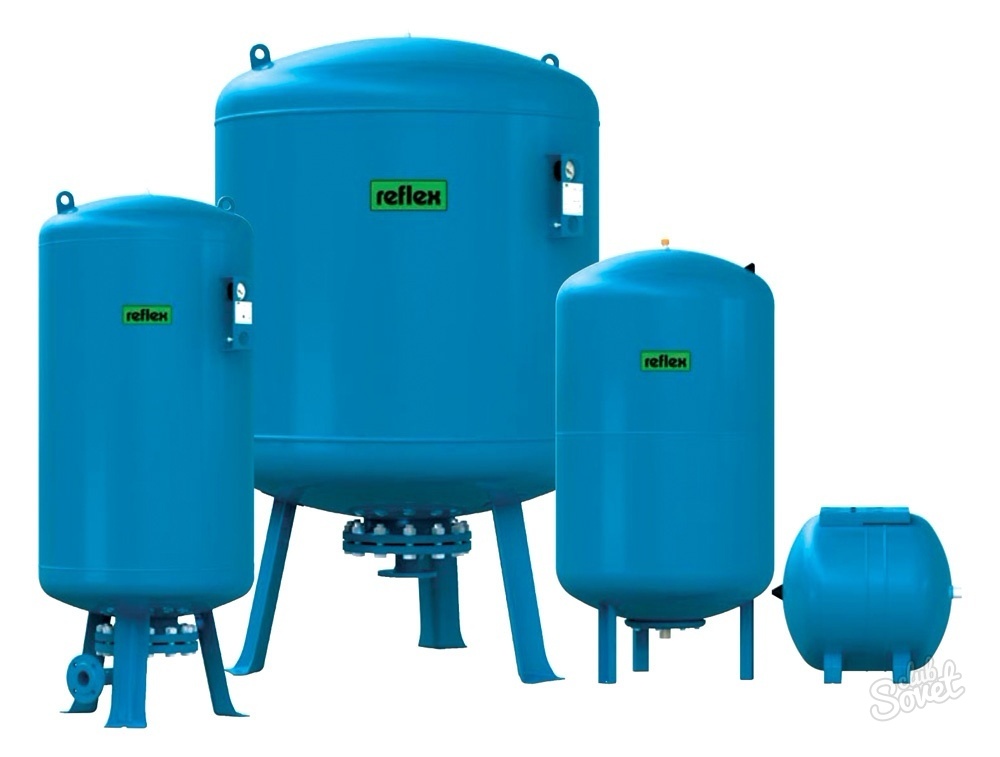
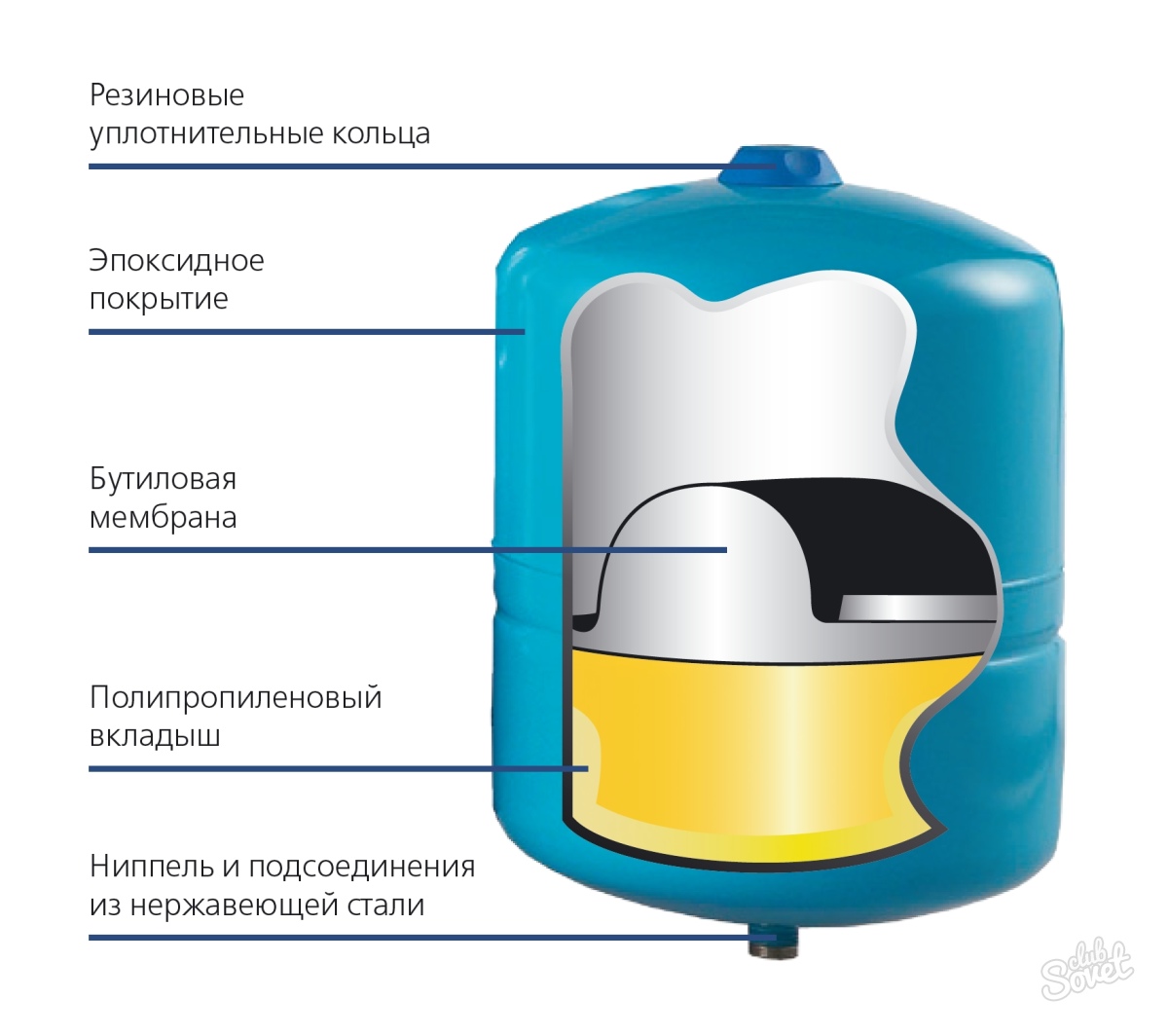
- increased reliability of the entire structure as a whole;
- ease of mounting this type of tanks;
- contact of the coolant with air is excluded, which reduces the oxidation of metal parts upon contact with water;
- greater efficiency when compared with other types of tanks;
- the absence of any evaporation due to the membrane mechanism;
- you can place the tank in any convenient place;
- there is no need for additional insulation of the tank.
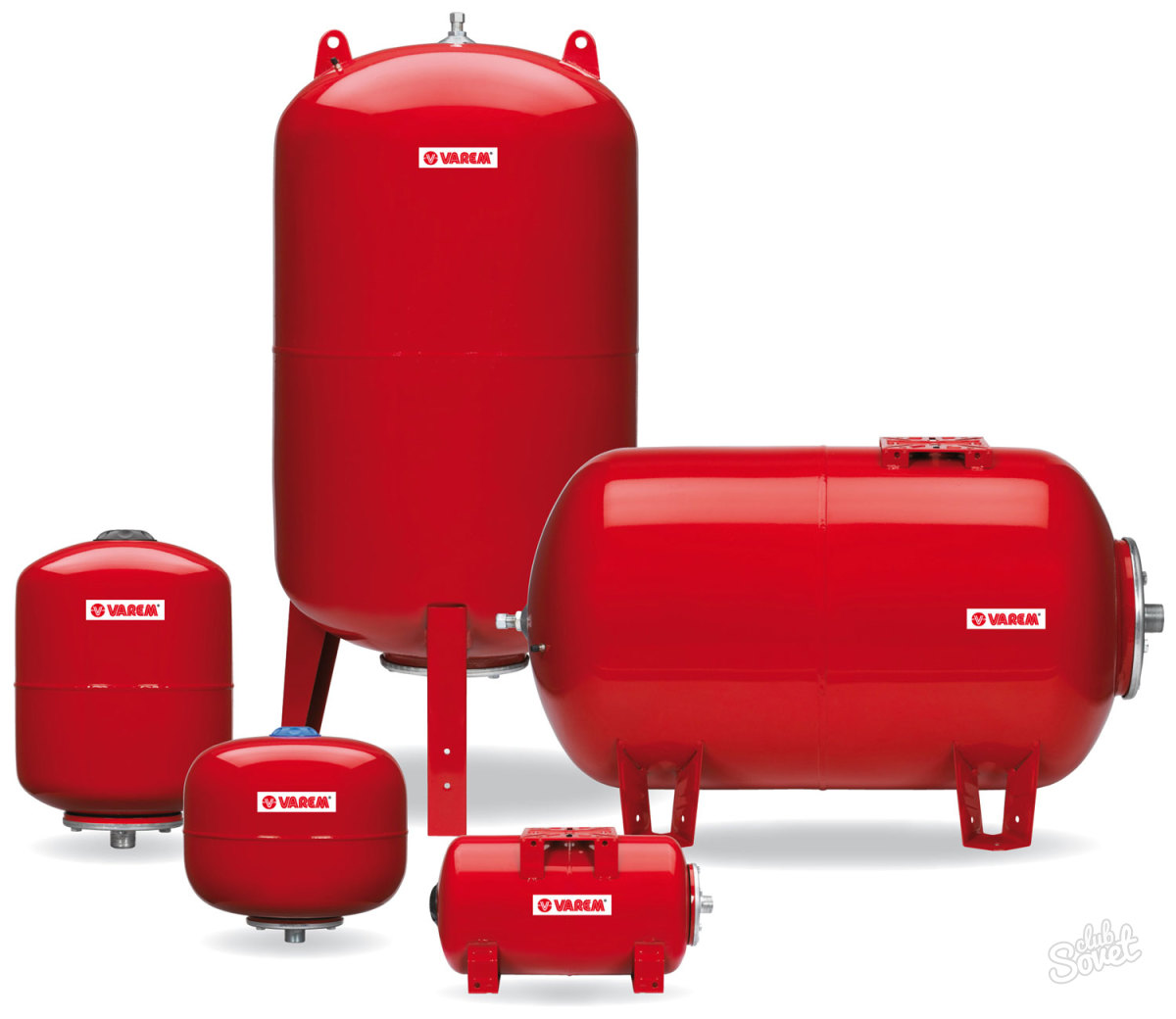
V \u003d ((e x C) / (1 - (P o / P m))) / Kzap, where:
V is the required volume of the tank.
e is the expansion coefficient of the liquid that is in the system. It is also necessary to take into account the maximum temperature of the coolant. For water, this indicator at a temperature of 85 ° C is 0.034.
C is the total volume of fluid in the heating system. Here, take into account the volume in radiators and pipes, the volume of the boiler tank and other elements with coolant.
P o - minimum pressure in the tank. This indicator should not be less than the pressure of the entire heating system at the location of the tank.
P m is the maximum pressure that the safety valve can withstand.
Kzap - coefficient of use of the internal volume of the tank, in percent. Its value is equal to the ratio of the volumes of the filled tank to the maximum possible volume of the coolant.
The figure below shows data that will help determine the maximum tank capacity:
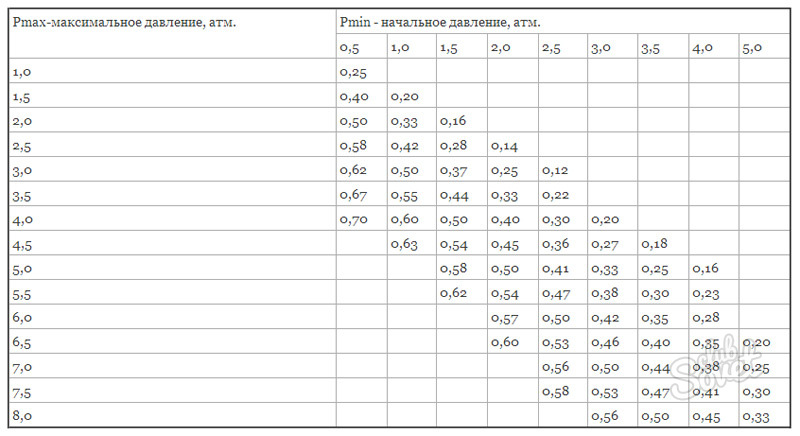
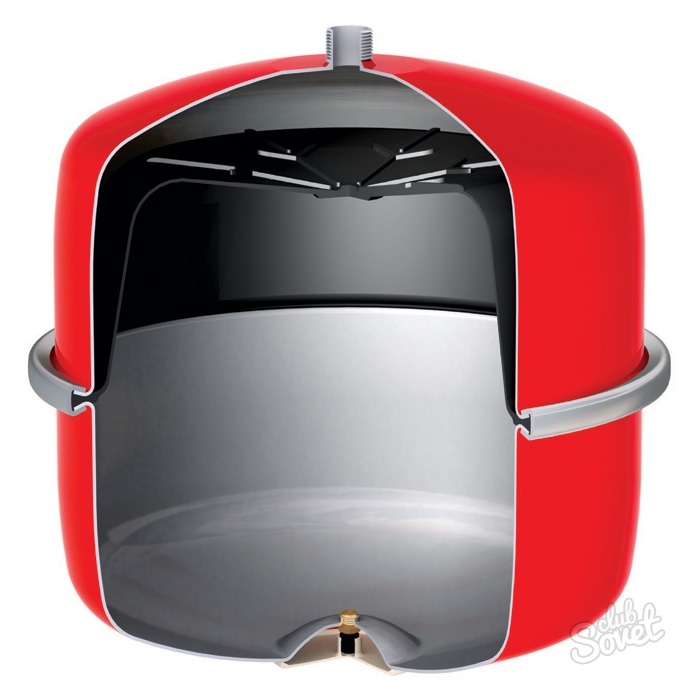
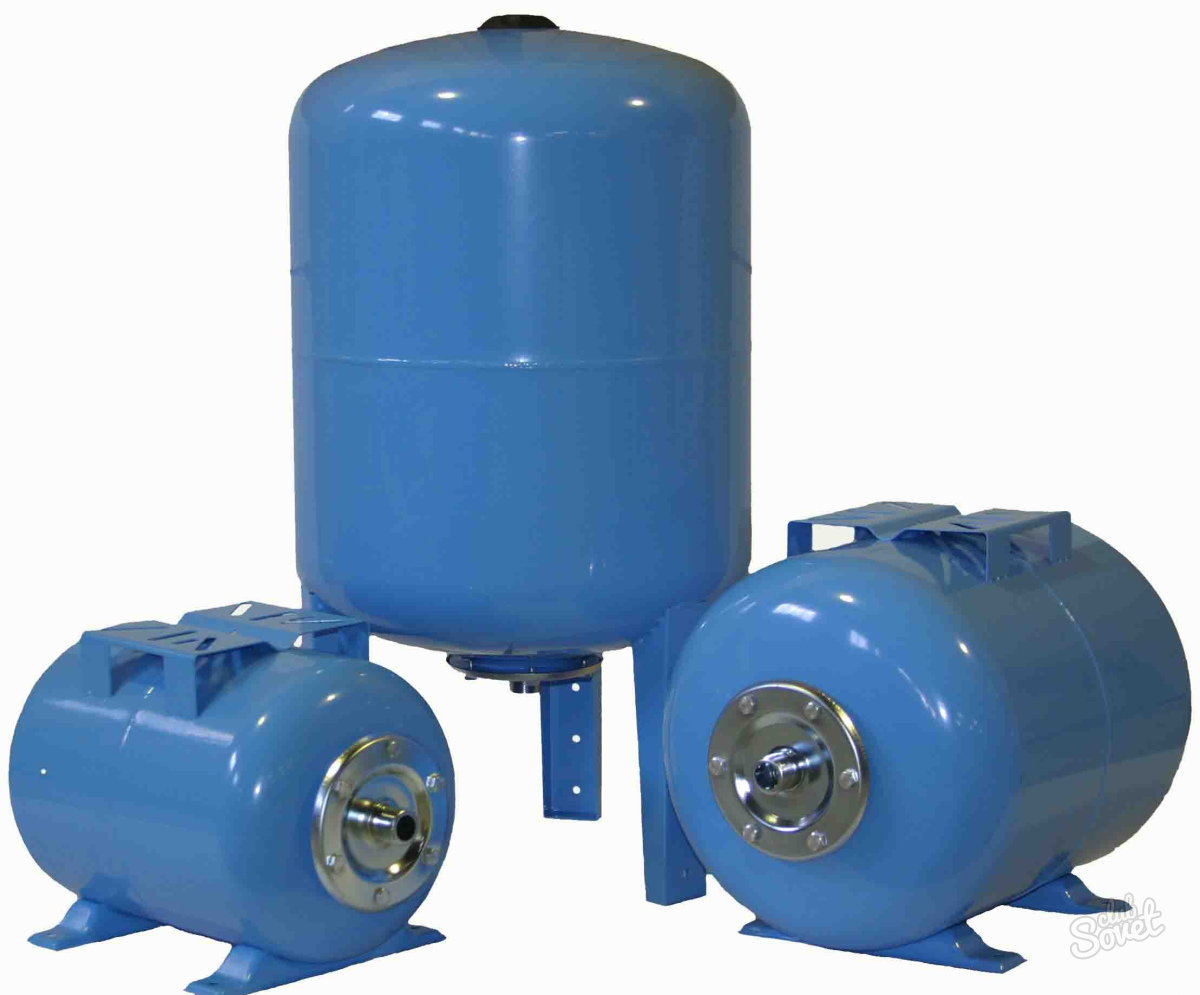
Choosing an expansion tank is not the most difficult part in designing your own heating. The question of the next level of complexity is its correct installation. It is better to entrust this issue to professionals so as not to hide in the cold winter with another blanket.
One of the components of the water heating system is the expansion tank. In order to decide which expansion tank to purchase, you need to answer two questions:
What heating system will be installed - open or closed?
What is the volume of coolant (water) in the system?
So, let's start in order.
Open and closed heating systems
As a rule, when choosing open or closed heating, electricity plays an important role, or rather its presence.
If there are frequent interruptions with it or it is completely absent, then install open system heating with natural circulation. It does not need light, only fuel is enough.
In this case, you need open type expansion tank. In fact, this is a metal box that you can make yourself.
![]() In all other cases, set . This is more modern equipment that prevents water hammer, maintains a constant pressure in the heating system, and increases the life of the pump.
In all other cases, set . This is more modern equipment that prevents water hammer, maintains a constant pressure in the heating system, and increases the life of the pump.
To summarize: if there is no electricity or there are frequent interruptions with it, then we choose an open expansion tank, if there is electricity, we choose a modern membrane expansion tank.
Expansion tank calculation
After choosing between membrane or open expansion tanks, you need to choose a tank by volume.
According to rough estimates, the volume of the expansion tank should be equal to 15% of the total volume of water in the system.
It's not as hard to do as many websites say.
The total volume of water in the system is made up of several components:
1. Amount of water contained in the heating boiler. These data are indicated in the technical data sheet.
 2. The volume of water in heating radiators. These figures should be included in technical specifications for each type of radiator.
2. The volume of water in heating radiators. These figures should be included in technical specifications for each type of radiator.
For example, one section of a Soviet cast-iron battery holds 1.8 liters of water, modern cast iron batteries 1 l, section of bimetallic radiators 0.25 l.
3. And the last term will be the amount of water in the pipes.
V total \u003d π * D 2 * L / 4 where π= 3.14, D is the inside diameter of the pipe and L is the length of the pipe.
Before calculating, do not forget to convert all numbers to centimeters. If the pipe diameter is 20 mm, then in centimeters it will be 20/10 \u003d 2 cm.
After counting, you will get the number expressed in centimeters. To convert this number to liters, divide it by 1000.
Example:
Pipe inner diameter D = 20 mm, pipe length L = 10 m.
Converting to centimeters:
D=20mm=20/10=2cm;
L= 10 m = 10*100 = 1000 cm.
We calculate the volume:
V total \u003d π * D 2 * L / 4 \u003d 3.14 * (2 cm) 2 * 1000 cm / 4 \u003d 3140 cm 3.
Converting to liters:
3140 cm 3 \u003d 3140 cm 3 / 1000 \u003d 3.14 liters.
Thus, adding up the volumes in the boiler, radiators and pipes, you can calculate the volume of the expansion tank. Recall that it should approximately equal 15% of the total volume.





